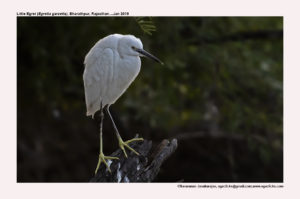Little-egret

Little Egret Egretta garzetta
Etymology:
- Egretta : French word French Aigrette for egret
- Garzetta : Italian name for Little egret
Vernacular Names: Sind: Bararo, Hindi: Kilchia or Karchia bagla, Sans: Shudra balaka, Pun: Bauna bagia, Ben: Chota korche bak, Ass: Bamoni bog, Teteri bog, Guj: Kilichio, Nano dhol bagalo, Mar: Lahan bagla, Chota pisal bagla, Udanch, Ta: Chinna vellai kokku, Te: Chinna tella konga, Mal: Chinna munti, Kan: Sanna bellakki, Sinh: Sudu kokka
Distribution in India: Wide spread resident except for Himalayas and Rajasthan. Local winter migration in Central India
Description: Size of 55-65 cm. Its plumage is normally entirely white. In the breeding season, the adult has two long plumes on the nape that form a crest. These plumes are pointed and very narrow. During the winter the plumage is similar but the scapulars are shorter and more normal in appearance. The bill is long and slender and it and the lores are black. There is an area of greenish-grey bare skin at the base of the lower mandible and around the eye which has a yellow iris. The legs are black and the feet yellow.
Habitat: It is found in lakes, rivers, canals, ponds, lagoons, marshes and flooded land, the bird prefers open locations to dense cover. Also seen in mangrove areas, swamps, mudflats, sandy beaches and reefs. The bird often moves about among cattle or other hoofed mammals.
Food Habits: It eats wide range of prey, particularly insects, especially grasshoppers, crickets, flies , and moths, as well as spiders, frogs, and earthworms . It uses a variety of methods to procure their food; they stalk their prey in shallow water, often running with raised wings or shuffling their feet to disturb small fish, or may stand still and wait to ambush prey. It makes use of opportunities provided by cormorants disturbing fish or humans attracting fish by throwing bread into water. On land they walk or run while chasing their prey, feed on creatures disturbed by grazing livestock and ticks on the livestock, and even scavenge.
Breeding Habits: They nests in colonies, which are often found around bodies of water. The colonies are usually found in woodlands near lakes or rivers, in swamps, or on small inland or coastal islands, and are sometimes shared with other wetland birds.The nest is a small untidy platform of sticks in a tree or shrub constructed by both parents. Sticks are collected by the male and arranged by the female, and stick-stealing is rife.The clutch size is three to five eggs, incubated by both adults for 21 to 25 days before hatching. The chicks begin to leave the nest and climb around at 2 weeks, fledge at 40 days and become independent at around the 45th day.